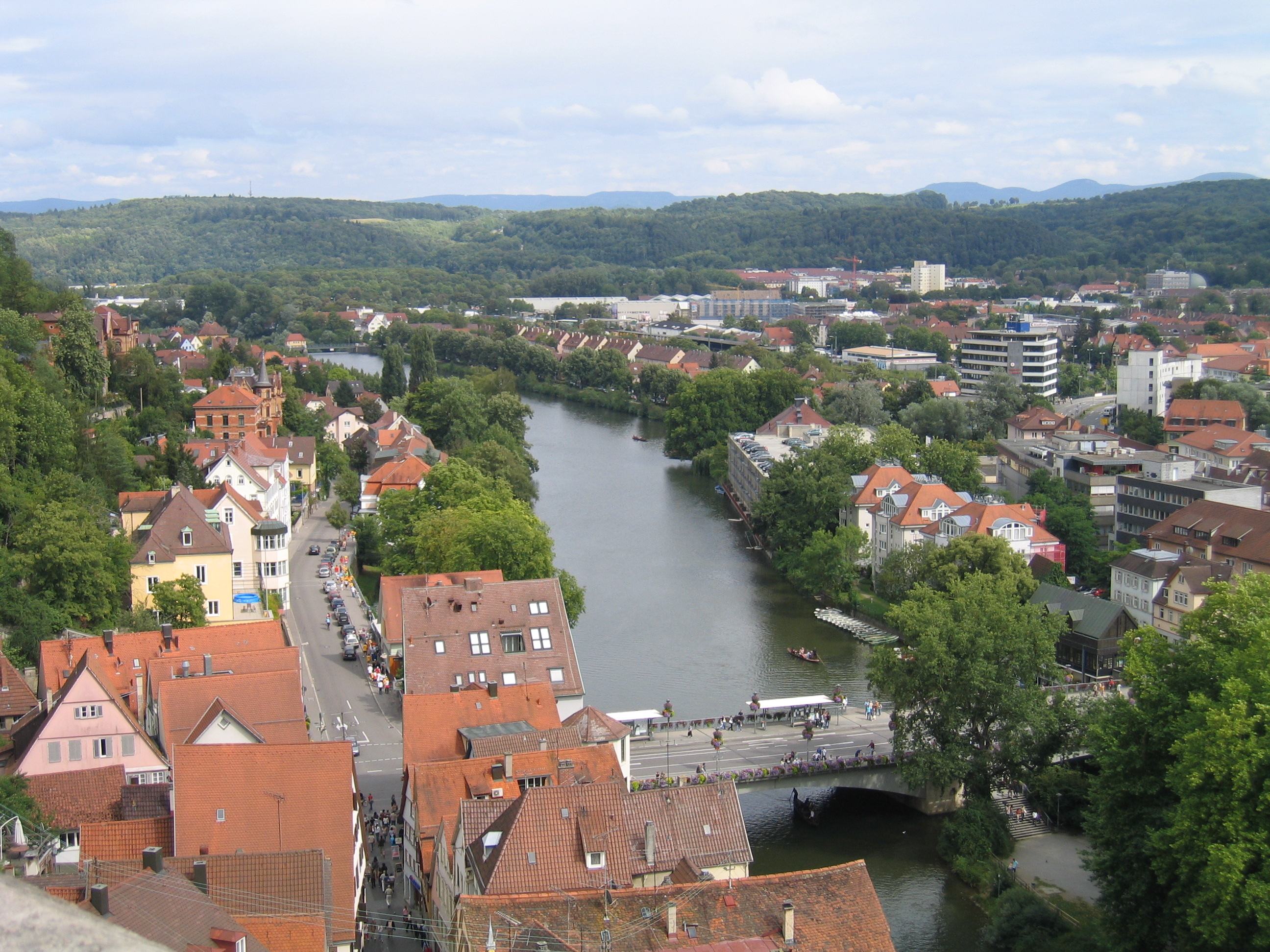|
Tübingen Triangle
The Tübingen triangle is a form of substitution tiling. It is, apart from the Penrose tiling, Penrose rhomb tilings and their variations, a classical candidate to model 5-fold (respectively 10-fold) quasicrystals. The inflation factor is – as in the Penrose case – the golden mean, \varphi=\frac = \frac \approx 1.618. The prototiles are Robinson triangles, but the relationship is different: The Penrose rhomb tilings are locally derivable from the Tübingen triangle tilings. These tilings were discovered and studied thoroughly by a group in Tübingen, Germany, thus the name. They can be obtained by cut-and-project on the 5-cell honeycomb. Since the prototiles are mirror symmetric, but their substitutions are not, left-handed and right-handed tiles need to be distinguished. This is indicated by the colours in the substitution rule and the patches of the relevant figures.E. Harriss (Drawings of 2005-12-01) und D. Frettlöh (Text of 2006-02-27)Tuebingen Triangle. Downloaded on ... [...More Info...] [...Related Items...] OR: [Wikipedia] [Google] [Baidu] |
Substitution Tiling
In geometry, a tile substitution is a method for constructing highly ordered Tessellation, tilings. Most importantly, some tile substitutions generate aperiodic tilings, which are tilings whose prototiles do not admit any tiling with translational symmetry. The most famous of these are the Penrose tilings. Substitution tilings are special cases of finite subdivision rules, which do not require the tiles to be geometrically rigid. Introduction A tile substitution is described by a Set (mathematics), set of prototiles (tile shapes) T_1,T_2,\dots, T_m, an expanding map Q and a dissection rule showing how to dissect the expanded prototiles Q T_i to form copies of some prototiles T_j. Intuitively, higher and higher iterations of tile substitution produce a tiling of the plane called a substitution tiling. Some substitution tilings are Periodic function, periodic, defined as having translational symmetry. Every substitution tiling (up to mild conditions) can be "enforced by matchin ... [...More Info...] [...Related Items...] OR: [Wikipedia] [Google] [Baidu] |
Penrose Tiling
A Penrose tiling is an example of an aperiodic tiling. Here, a ''tiling'' is a covering of two-dimensional space, the plane by non-overlapping polygons or other shapes, and a tiling is ''aperiodic'' if it does not contain arbitrarily large Periodic tiling, periodic regions or patches. However, despite their lack of translational symmetry, Penrose tilings may have both reflection symmetry and fivefold rotational symmetry. Penrose tilings are named after mathematician and physicist Roger Penrose, who investigated them in the 1970s. There are several variants of Penrose tilings with different tile shapes. The original form of Penrose tiling used tiles of four different shapes, but this was later reduced to only two shapes: either two different rhombus, rhombi, or two different quadrilaterals called kite (geometry), kites and darts. The Penrose tilings are obtained by constraining the ways in which these shapes are allowed to fit together in a way that avoids periodic tiling. This ma ... [...More Info...] [...Related Items...] OR: [Wikipedia] [Google] [Baidu] |
Quasicrystal
A quasiperiodicity, quasiperiodic crystal, or quasicrystal, is a structure that is Order and disorder (physics), ordered but not Bravais lattice, periodic. A quasicrystalline pattern can continuously fill all available space, but it lacks translational symmetry. While crystals, according to the classical crystallographic restriction theorem, can possess only two-, three-, four-, and six-fold rotational symmetries, the Bragg diffraction pattern of quasicrystals shows sharp peaks with other symmetry orders—for instance, five-fold. Aperiodic tilings were discovered by mathematicians in the early 1960s, and some twenty years later, they were found to apply to the study of natural quasicrystals. The discovery of these aperiodic forms in nature has produced a paradigm shift in the field of crystallography. In crystallography, the quasicrystals were predicted in 1981 by a five-fold symmetry study of Alan Lindsay Mackay,—that also brought in 1982, with the crystallographic Fourier t ... [...More Info...] [...Related Items...] OR: [Wikipedia] [Google] [Baidu] |
Tübingen
Tübingen (; ) is a traditional college town, university city in central Baden-Württemberg, Germany. It is situated south of the state capital, Stuttgart, and developed on both sides of the Neckar and Ammer (Neckar), Ammer rivers. about one in three of the 90,000 people living in Tübingen is a student. As of the 2018/2019 winter semester, 27,665 students attend the University of Tübingen, Eberhard Karl University of Tübingen. The city has the lowest median age in Germany, in part due to its status as a university city. As of December 31, 2015, the average age of a citizen of Tübingen is 39.1 years. Immediately north of the city lies the Schönbuch, a densely wooded nature park. The Swabian Alb mountains rise about (beeline Tübingen City to Roßberg - 869 m) to the southeast of Tübingen. The Ammer and Steinlach rivers are Tributary, tributaries of the Neckar river, which flows in an easterly direction through the city, just south of the Middle Ages, medieval old town. La ... [...More Info...] [...Related Items...] OR: [Wikipedia] [Google] [Baidu] |
5-cell Honeycomb
In Four-dimensional space, four-dimensional Euclidean geometry, the 4-simplex honeycomb, 5-cell honeycomb or pentachoric-dispentachoric honeycomb is a space-filling tessellation honeycomb (geometry), honeycomb. It is composed of 5-cells and rectified 5-cells facets in a ratio of 1:1. Structure Cells of the vertex figure are ten tetrahedrons and 20 triangular prisms, corresponding to the ten 5-cells and 20 rectified 5-cells that meet at each vertex. All the vertices lie in parallel realms in which they form alternated cubic honeycombs, the tetrahedra being either tops of the rectified 5-cell or the bases of the 5-cell, and the octahedra being the bottoms of the rectified 5-cell. Alternate names * Cyclopentachoric tetracomb * Pentachoric-dispentachoric tetracomb Projection by folding The ''5-cell honeycomb'' can be projected into the 2-dimensional square tiling by a Coxeter–Dynkin diagram#Geometric folding, geometric folding operation that maps two pairs of mirrors into each ... [...More Info...] [...Related Items...] OR: [Wikipedia] [Google] [Baidu] |



